This is part 2 of my conversation with Asger about Heat: Pedal to the Metal. The full conversation was 90min long, so I had to edit it down a bit and split into two parts for better readability. If you haven’t read part 1, you should do so here.
In this part, we talk about the design of the Legends (the much praised automa system enabling epic races even for solo and smaller player counts), their partnership with Days of Wonder, and how their input helped shape the product we have now, the challenges of fulfilling huge demand, and how they approach future content. Enjoy!
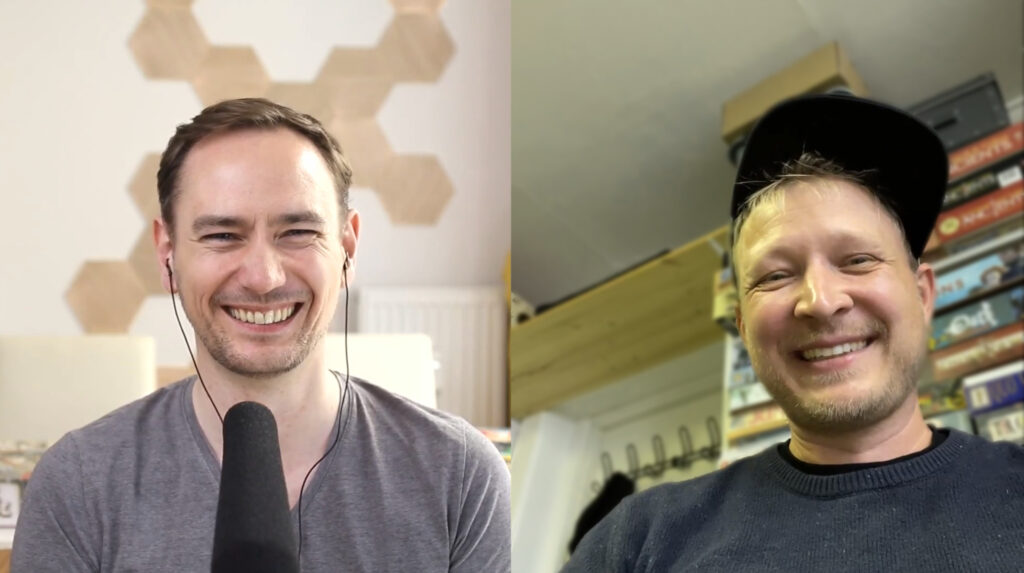
The Legends
Another element I have to mention are the Legends. Every review I found was like “man, this is great”! They are fast to use, they are challenging, interesting, again – as you said – the illusion of racing: they are giving you this stream of lots of overtaking all the time. Did you already realise in the beginning that you needed such a mechanism or was it later added on?
It wasn’t added in the very beginning, but we knew we wanted it from the beginning. We knew we wanted a race to feel like not just two cars racing against each other because the cars are important interaction points for you. And any good game is not just a solo game of you not affecting anyone else. It’s you thinking about what the others are doing. If the others become part of your dilemmas, they can become part of your regrets and then the game becomes an even richer world from the fact that you will always have to second guess what they are doing. And once you have learned it, then maybe they learned that you learned it. So we are in a catch 22 situation.
I can’t remember how early we started working on the legends but we have tried – I don’t know – twenty different ways of doing it. And maybe the last ways were versions of what it is now, [leading to it]. For a long time, it was more or less what it is but people had a very hard time understanding it despite it being the same rules. The choice of printing some of the features on the map [helped] people understand where [the Legend] is. While the rules were the same before, you [at that time] had to do the math and understand it. [That] really was the last big jump to make this system the one that is so easy to use. Sometimes you can have the technically exact same rules but the experience and the gameplay for people is entirely different because they are being asked to do different things mentally from it.
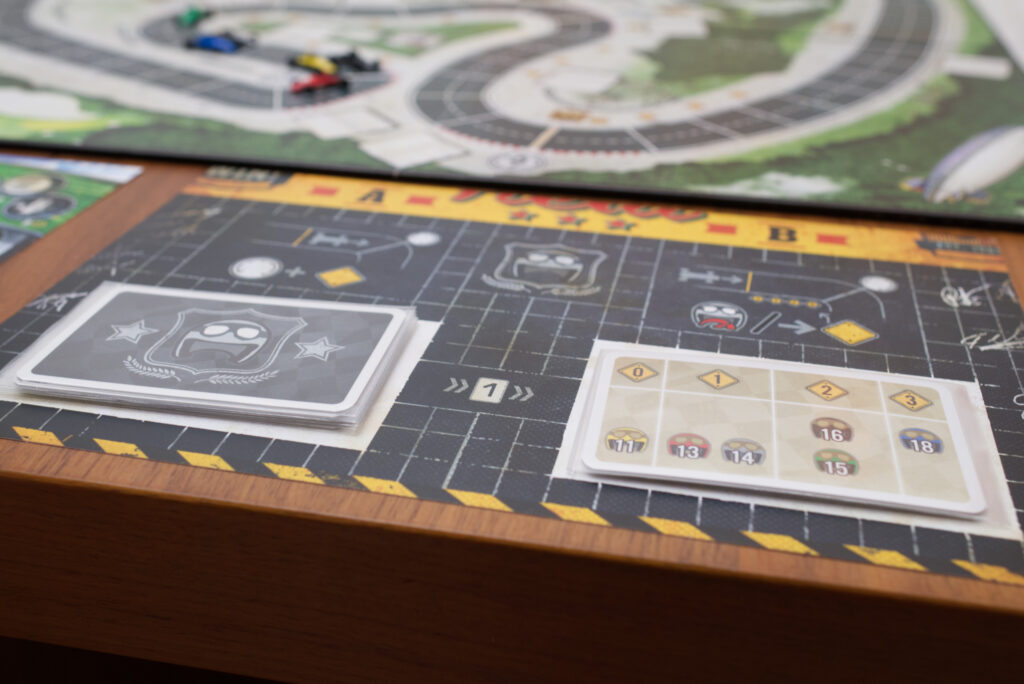
I read you had a friend write a computer program to help you balance your design. How detailed was it and what did you learn from it?
So all it did was it ran the different numbers for the colours, so it had the distribution of them. It just ran them pretending there were no other [cars] on the track. It wasn’t like a simulation where they are actually doing races. It was just let’s assume [a colour is] just racing [a track]. So we then figured that we knew what is technically possible for a human to achieve, like in how many rounds can you finish a race in. And we knew that we didn’t want the legends to – even [with a small likelihood] – finish faster than it’s possible for the humans.
So we wanted – I don’t know, what do you call it – a normal distribution to be around where they would fit and occasionally push towards the absolute best possible and either distribution end. Because obviously they are just random. So you can have very unlucky legends and very lucky legends depending on when they draw their cards and where they are at the time.
That created some of my favourite threads where it’s like “is the red legend more powerful than the black one?” and so on.
Gamers want data. [laughs]
Since so many people rave about this mechanism – both for solo play but also if you are like two or three players – has that influenced how you think about automa for the other games you are designing? Is it suddenly “oh, we have to level up our game when it comes to automa”?
Yes. Of course it’s very different from game to game. But we try to make solo versions for all our games, and for some of them it has been a focus that we have grown towards over the last few years. So it’s not something that has always been as apparent to us. The big difference is that in some games you might be sitting and playing on your own board, which is an entirely different solo automa. Maybe there is slight interaction in the market – who takes what from you or something like that – where in a car racing game they have to be in there and have to act like human players in a relatable manor. Or at least – again – the illusion of acting like a human driver.
So it is something we are focusing on and I think most of the games we will be doing in the future will have a strong solo automa mode, at least the ones we are working on currently.
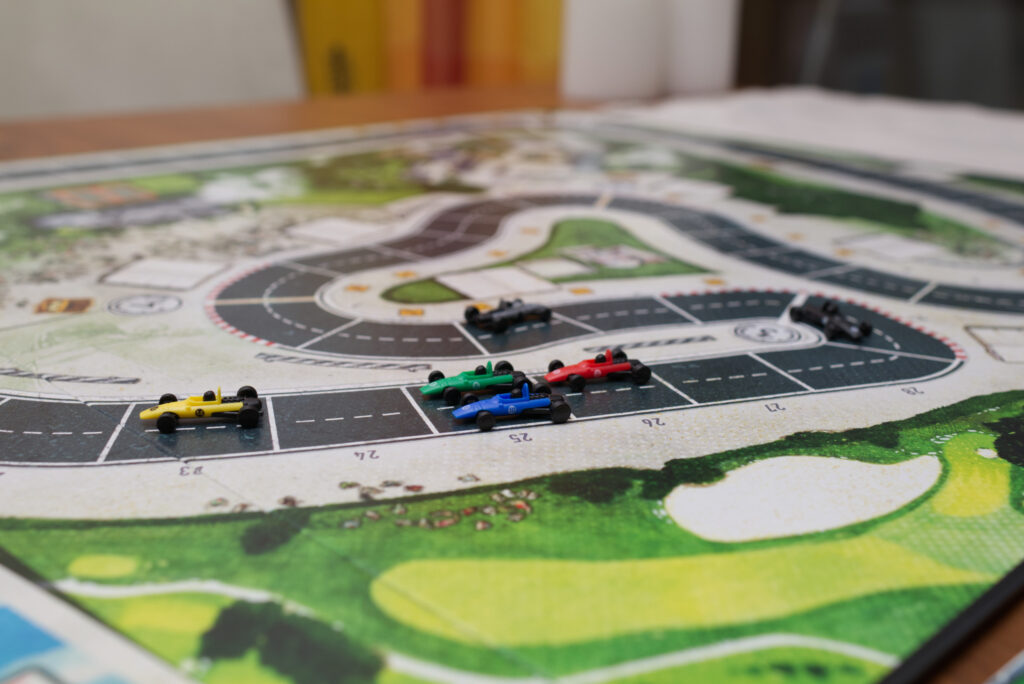
The Published Version
Let’s jump to the present. We now have this published version from Days of Wonder. Why was Days of Wonder your first choice?
When we started in the industry, they were the go-to people that did the best productions and biggest games and had all the buzz. Of course so many companies have since then followed in the foot steps of Days of Wonder. If you look at Ticket to Ride today, it is no longer what it was then, which was an OUTSTANDING production quality ABOVE everything else. And these days everyone does even more.
But they were part of our vision. We knew they could handle all aspects of it. We had already worked with them on Deep Blue, which was the first game we had released with Days of Wonder. So we knew they were good to work together with as well and we trusted that they could take it to where it should be. And again the weight of the game, etc. fitted what we saw them doing. They have since the Ticket to Ride days – and then Five Tribes did a little more gamer’s game – [been] gravitating slightly towards more complicated games. Even if there is a very simple game at the core of Heat.
One thing I found during my research was that you were talking about how difficult it is to even publish a sports board game. So how difficult was it to convince Days of Wonder? Where they like “these are the Flamme Rouge guys, we take this car game, sure” or did you have to pitch it to them?
Obviously we pitched it to them. However, it was quite easy. There is an anecdote which is funny – and apologies to Adrien and Franck for drawing them into this story. Adrien is the CEO of Days of Wonder and we had a meeting pitching it to him and Franck, [who] also works in Days of Wonder with game development and project management and other stuff. I knew from past Essens and from forums that Franck was a very big Flamme Rouge fan. So when we had the pitch, Franck was sitting in the SPIEL booth at Essen while we were going in and I told Adrien “it’s much better if we are four”. [both laugh hard]
We dragged Franck into the play test and obviously he became the lead internally in Days of Wonder from the very first pitch and was a fan. Not only I knew he was a Flamme Rouge fan, I also knew he was a racing game fan.
So you were talking about development. As someone who has never published a board game myself, tell me what the collaboration with Days of Wonders was like. Did you basically hand them the finished game or did they help you develop it?
So I think I’d say that 90-95% of development was Daniel and I. However, often in the process if there is something they don’t like, they will push back. They would tell us “we think you should … think about this again”. They rarely tell us what we should do.
At one moment, we were testing different ways of making the customisability of the cars. We had been pursuing the idea that players might want to have a car that had special traits built into that player board. Imagine the player board and now you look at the flip side of the player board. Instead of having those 100 customisable cards and building your own car, you now had the fast car or the [car that was good] in the corner or whatever because then we could also illustrate some characters fitting to that kind of player board. You could tell more of a story if we’d take ownership of what types are being presented.
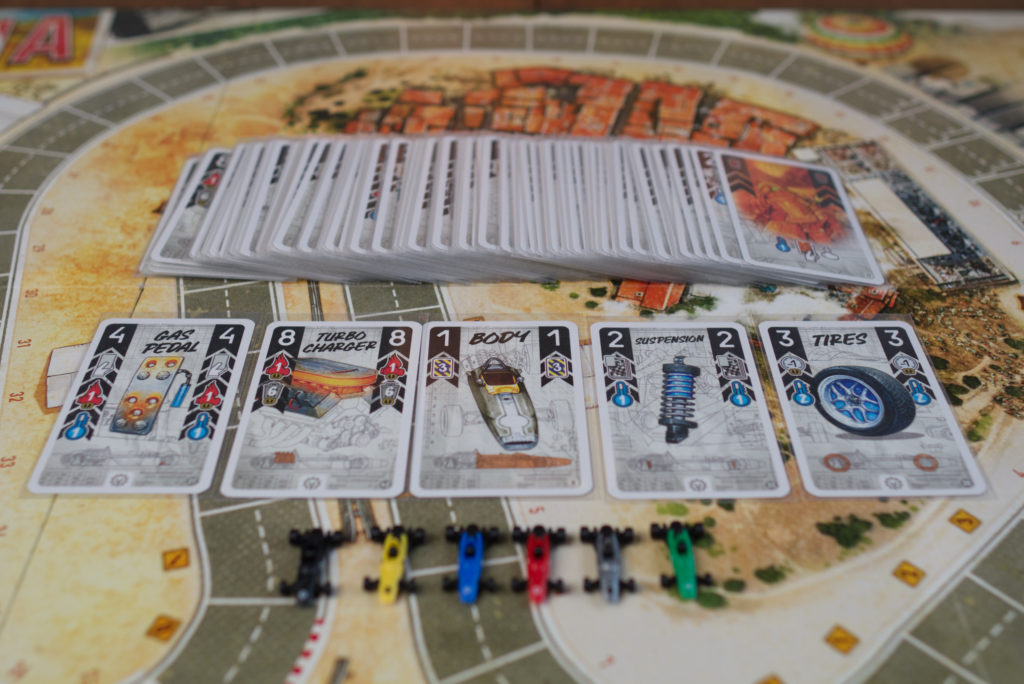
We had been pursuing that and then we actually were in a three day development work session in Paris with the Days of Wonder team and after the first day of pitching it again, Adrien pushed back and said he really liked the old version where you could build your own cars. And we had also had lots of [discussions about] it and we still insisted and insisted. But then we went home, we slept, we woke up, we had our breakfast. And we came back to the office and by that time we had said “you are probably right” [laughs]. “So let’s go back to this”.
And I’m very happy that we did. I think one of the ways I still talk about that way of making a game – instead of giving players a set thing – [is that] I think from a design perspective there are two interesting dilemmas involved in it: One is that if you give players six or eight different cars that are pre-made, then players will have strong opinions about which one is bad or good. They will feel cheated even if it is not true. It doesn’t matter, it’s irrelevant, because the feeling will be there that some injustice has happened.
That’s the one thing that then alleviates if you build it yourself because it’s then not me as the designer who’s responsible for it. It’s you as a player who’s responsible for the choices you made. Or it’s you in the draft who’s responsible for letting that player pick that combination.
On top of it, much like when you are building a deck in Magic the Gathering or building a team for Blood Bowl or an army for Warhammer, it means that you are engaging with the game outside the game. You are not playing the game but you are thinking about the game and combinations that “if I could get this with this and then that, oh wow, and then on this track, and I can go like that”. Allowing the large combination of upgrade cards and for people to build it themselves means that it has this potential of dreaming what could be and thinking about it.
One of the major questions that’s on the tip of my tongue and I always wanted to ask is: who decided to put so much content into this one box? Was this sort of a hail Mary, like “we don’t know if it will be a success or not, we don’t know if there ever will be expansions, aw, just put it all into the base game” or where did it come from that there are so many different things in the game?
It’s absolutely also a hail Mary. But I think the main reason is probably COVID. So COVID meant that the game got delayed for up to two years. Depending on how ambitious we thought we could have been, it might have been out two years [earlier]. However, it also meant that we didn’t stop working on this first expansion [both laugh]. And even from the beginning, it was a discussion: we always knew that players – if they liked it – would want more tracks and more stuff immediately.
So from the beginning, it was a discussion if we should release a big box – or even more – if we should release two boxes simultaneously or very shortly after each other. And then they went out and talked to so many of their partners and [there were] different messages one way or another. It was still not out in Germany in the first print run among others because a lot of German publishers and distributors don’t believe in sports games or racing games and in expansive games. The price point has also been an issue in other territories.
So it was back and forth for a long time and then eventually it was decided by Days of Wonder. I think even I argued against it, I wanted the two boxes. But I’m very, very, very happy with hindsight that it was one box. […] Very shortly after Flamme Rouge was released, I got the permission from the publisher to post a Grand Tour self-play expansion on BoardGameGeek. So the fact that whoever becomes a fan of [Heat] has the potential to dive in and get really submerged and it [can] almost become like a life-style game for them and [they don’t] have to wait two and a half years for the next expansion and then have forgotten about it in the meantime … So that way of giving people enough [content] we think is part of the success. Of course it’s almost impossible to decipher what exactly caused what.
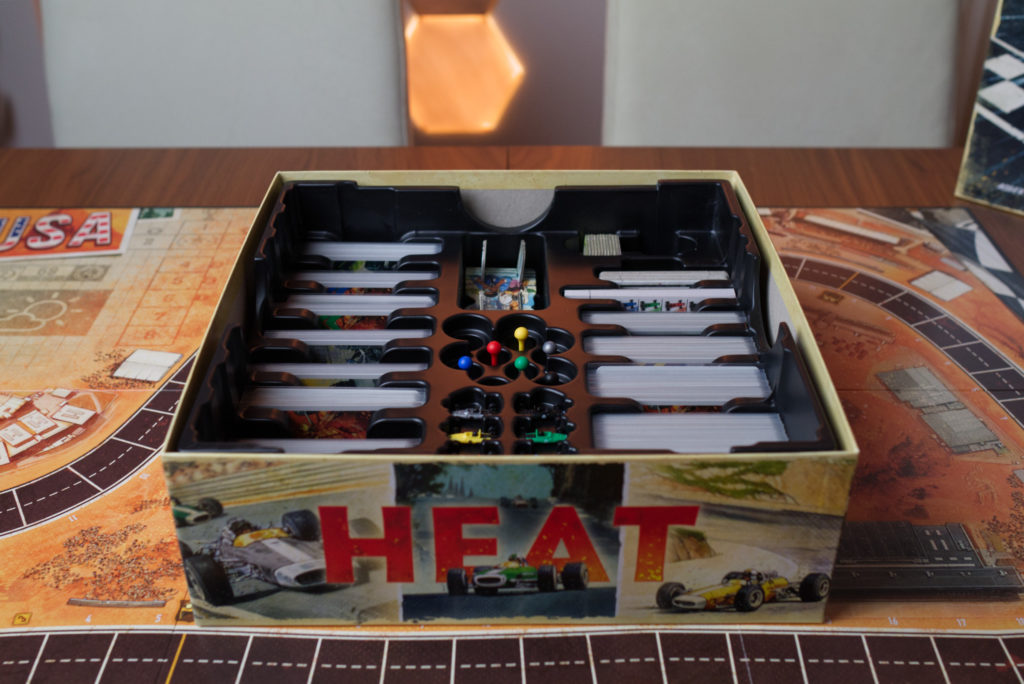
I think so, too. It’s such an amazing experience. You don’t feel like someone is ripping you off because there is so much in there. And then you find another thing. It’s like finding easter eggs almost, like “oh, this is so much more than I expected”.
And you have bought it and you have the feeling that “oh, at least I have to try the four tracks”, right? [laughs] And then you have the feeling that “oh even if I want to I can …”. Because once you start learning those modules, you can see that even in this base game you will never need expansions. If you are in the place where you like it that much, then hopefully you will want them anyway, that’s what we hope [smiles]. But you will never need an expansion for this game. You can play it hundreds of times and still have new and interesting experiences.
You just mentioned it, this situation where Germany was left out of the first print run. When I read it, I was like “how could they, this is crazy”. But of course at that time it was already clear what a game and how much of a success Heat would be. Tell me about what the perception was like before the game came out. Was it worldwide that people were hesitant? […] Or was it just Germany?
It was mostly Germany. There were a few other territories. I think Italy was also a little bit late to it, which is a big Formula 1 country and you should have expected otherwise. I think for Germany it was like racing game fear and I think for Italy it was the price point. [jokingly] But you would have to interview them to get those answers for sure.
Before going full-time game design, […] I used to run a distributor, distributing games in the Nordics. It’s still running for the nordic regions. And I have encountered so many people that have gut reactions about what can and cannot be done. I was also told again and again “Flamme Rouge? You can’t make a game about sports bicycle racing”. And I think that people once they have experienced psychologically that something failed two or three times, they try to put a hook on why did it fail and that hook is just more gut reaction than anything actual data-oriented. Because to have actual data, you need hundreds of cases and to sort them into different categories, etc. But the human mind wants to think of it as data once you have seen something happen five times where the reality could be that maybe those five games were just not modern great games and maybe it’s not something against racing or against sports.
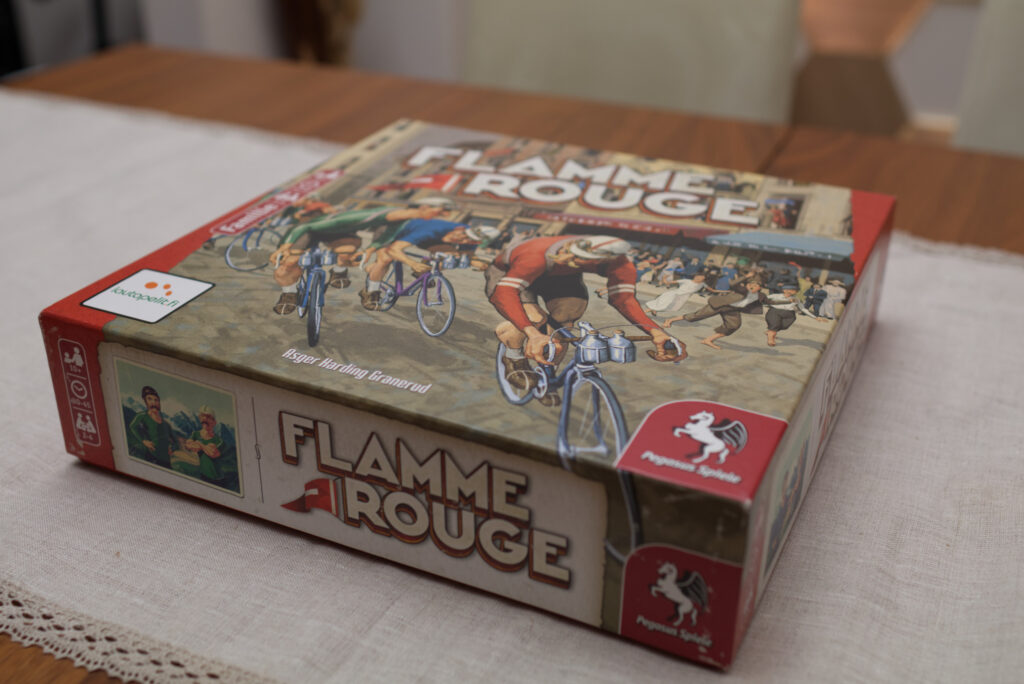
I don’t think that there is a sports bias in board games. I think that there will be someone that makes a football / soccer board game at some point that will take the world by storm because obviously the market is gigantic. But the problem is that a lot of the games in that genre being made today are being made by fans of the sports that don’t really know board games so it’s not great board game craft. And even so, it’s obviously a difficult thing to do because otherwise it would have been done. But I can’t see why it shouldn’t happen eventually. I don’t think there is anything against sports games, I think there is something against bad games. If a game is great, people will play it.
So when the game came out, the first reactions came in, and the first threads popped up you could read, how did it feel for you? Was it validation?
Absolutely. It was all we had hoped for because as you say when you read through those, or watch or listen to those many, many first reviews we knew – or at least we assumed – it would be compared to other racing games that [exist] and our goal was to be favourably compared to those games. And of course then there are all the details that people also like inside the game which is a little bit different from person to person. But we very much believe we succeeded in establishing potentially ourselves, potentially Heat as being THE car racing game of the hobby board game genre. And we also believe that in ten, or twenty, or thirty years Formula 1 racing out in the real world will still be a big enough thing that there will be still some interest in it.
Plus racing is just a good board gaming setting because it’s exciting. Who get’s there first? It’s easy to understand. So it was very exciting to have that validation that people said yes, this is as such. Of course then it was also then a game we had worked on for four years and had seen hundreds of reactions on, so we also had a strong idea that it would probably be positively received. But you never know, you never know. And sometimes if you are unlucky – like if the first two or three reviews from whoever it is were negative – then others will focus on some of those same aspects or at least talk about it instead of talk about all the things they liked. It worked out with hard work and luck.
And how is it to have so many people talking about your game? I have to imagine it’s like a flood pouring in on you.
That is absolutely beyond expectations. I think there is less than five days since SPIEL Essen last year where it has not been in the top ten [of most discussed games] of BoardGameGeek, right? [laughs] So the amount of attention it has gotten has completely blown both of us away. We thought and hoped people would like it and compare it favourably to Formula Dé but the fact that it almost instantly sells out as soon as containers full [of copies] arrive in new markets is still hard to believe. It’s like kind of a knock-on-wood thing and saying “when will it stop?”, right? Of course we want people to get it but we also want people to keep buying it really fast. [laughs]
I saw a thread yesterday where someone posted “oh, this and this store has gotten a hundred copies” and you could see a post 5 minutes later: “only 80”. Twenty minutes later “oh, they are all gone”. And I was like “a 100 copies in less than half an hour?”
And then there are all the stores that are selling at the same time which you don’t hear about, right. It seems like especially in the US at the moment that no store is able to keep it on the shelf for more than a day or two at a time – unless they are a friendly local game store and they don’t have an online presence. I’m sure you can find them. But for the most part it’s just literally ripped off the shelves. And that’s still crazy how fast it is gone, that’s insane.
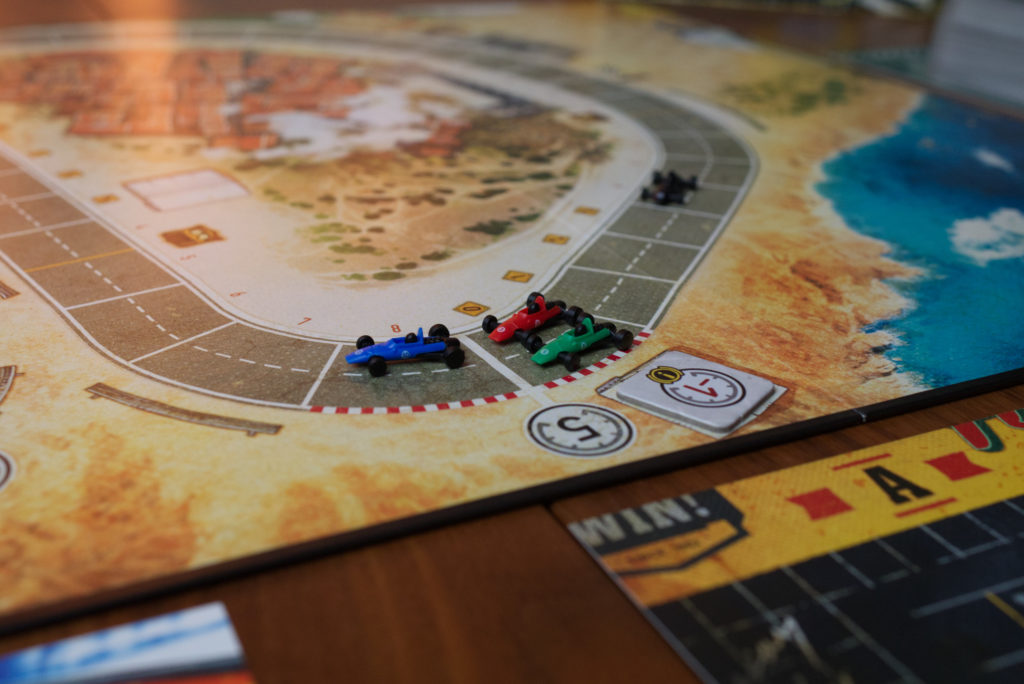
Do you have a feeling of whether this is limited to the BGG bubble – like people that are very well informed – or is it also people coming into the store that rarely play board games and they also pick up all the Heat copies.
I think … I don’t know, that’s the first thing I should say. But I think that generally it is probably very much the ambassador–gamer BGG crowd. Because I think it’s so little on shelves that people don’t have a big chance to go in and just randomly stumble across it and discover it, right? And you can also see – as you mention – on BoardGameGeek that there are these threads where people are complaining why we or Days of Wonder are so terrible at supplying this game. How can this be that we still can’t buy it? At the same time you can see that it’s selling out – like as you say – if they have a hundred copies, it’s gone in an hour as soon as it’s announced
I’m not sure if you are the right person or if I should ask Days of Wonder, but in your feeling, how does this shortage come up? Is it that nobody expected so many copies to sell or are there production limitations?
As far as I understand [it] … in any board game, if there is plastics done, it’s 99% of the time done in China. But the printing of Heat is done in Europe. So it means that two different production cycles have to align which also means that they pre-order some of them even before they have the sales [numbers], so that the plastics come in. But that then – because you have made those pre-order – limits the size of the print run you are going to be doing. And even if it is in the tens and tens of thousands, when you then have ten or fifteen territories wanting copies, it means that each territory doesn’t get quite as many as they would like. So of course you could chose to only send that print run to the US but then everyone else would instead be complaining, right?
[Jokingly] There would be riots in the streets.
And on top of it, several of these things to the consumer seem like “why didn’t you account for this?”. Well, now, sure it got a great review from this reviewer and a great review from that reviewer and it won this price. But all of those things are something the publisher and the distributor can take account for with a 3 or 4 [month] or sometimes longer delay. I believe it is being produced at one of the bigger German factories which is also one of the factories that obviously has the most business to do. So they are booked months in advance and you can’t just say I want it printed now because they have other things to print for other people.
Sure, especially just before Essen, everybody wants their slots to print something.
Even more so, yes.
When I talked to Ryan Laukat, he also […] described that there are a few games where it took them years to sell out the first print run and then he had Sleeping Gods and people were yelling like “how can I get this game?” and so on. For them it was also a challenge because of the delays and the preplanning being so long. And then it’s always a financial gamble, right? Is it just a hype and the spotlight will move on to the next thing at the point when you can fulfil it? So, tricky thing.
Yes.
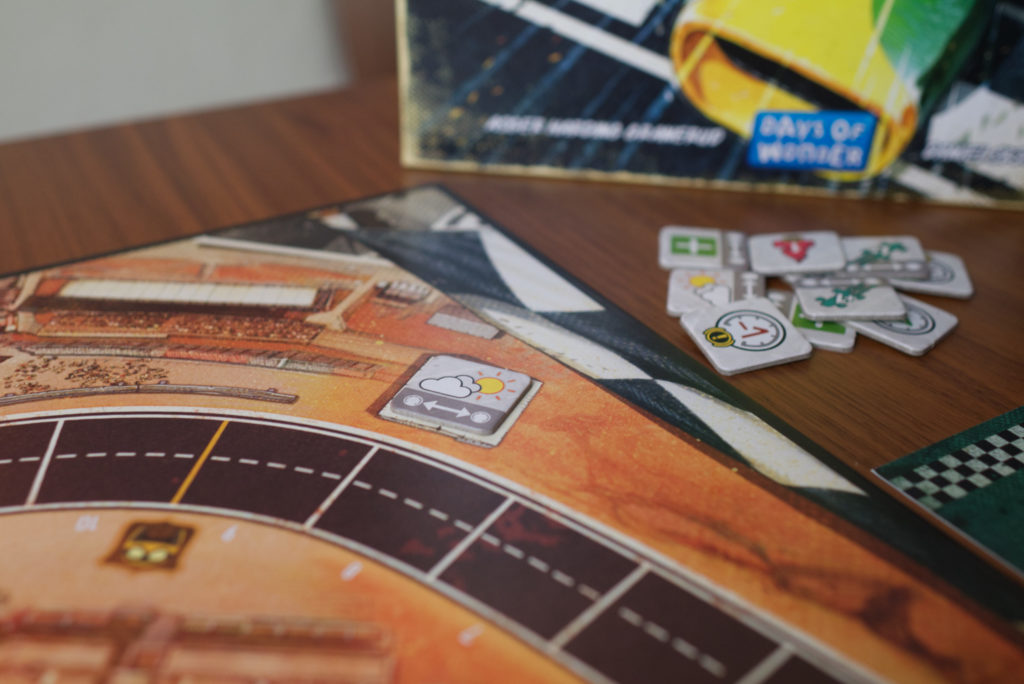
What’s Next?
Let’s look into the future now. You already showed a couple of things about the upcoming expansion. Like there will be one more player colour, two new tracks, puddles of rain. How far in the design process are you?
So the first expansion is done. I haven’t seen the new Vincent Dutrait art covers but they are working on it and they are working on the tracks and all these other things. So that’s on it’s way, yes.
I tried to convince Daniel to not wait six months and then start working on the second expansion, and then a year later work on the third, because I saw myself – it drags out and takes attention once you go in and out of a project – working the next like five years [for] half of the year doing Heat expansions.
So now we are working on up to and including like expansion seven or eight at once.
Oh wow [both laugh]
Which is of course also crazy, right? But it does a lot of things. It’s much more efficient [for] us and it allows us to think about what we wanna do in the future and we account for it in the present. And of course there is no guarantee from anyone that even expansion number two or three will be released. Of course with the sales of the base game it’s likely.
Let’s see if that first expansion also follows those sales in some meaningful manor and if it does that, then expansion two will be a given. So it’s a risk for us of investing a little more time now but it hopefully is gonna save us a lot of time and effort in the future. And not only that, also make a better product because we are thinking about all of it at once instead of piecemeal.
I also think all the energy and excitement will probably help you. I mean, if you come into a board game cafe anywhere in the world [right now] and say “I have the idea for expansion number eight, who wants to try it?”, probably everyone will say “yes” and [if you were waiting] two years, you probably would have to struggle to find play testers.
Yes, yes, yes. We had a playtest session in our club Saturday – I think two weeks ago – where we had 18 playtesters turn up and spend a day playing the different Heat expansions. And we are doing one again in three or four weeks in September and then one again in November and those are like the big ones. We already know what could be 90% of the expansions two, three and four. And we’re of course still making sure and getting closer and closer and closer, and then expansions five and six are a little more uncertain. We’ve got some very exciting ideas for that as well.
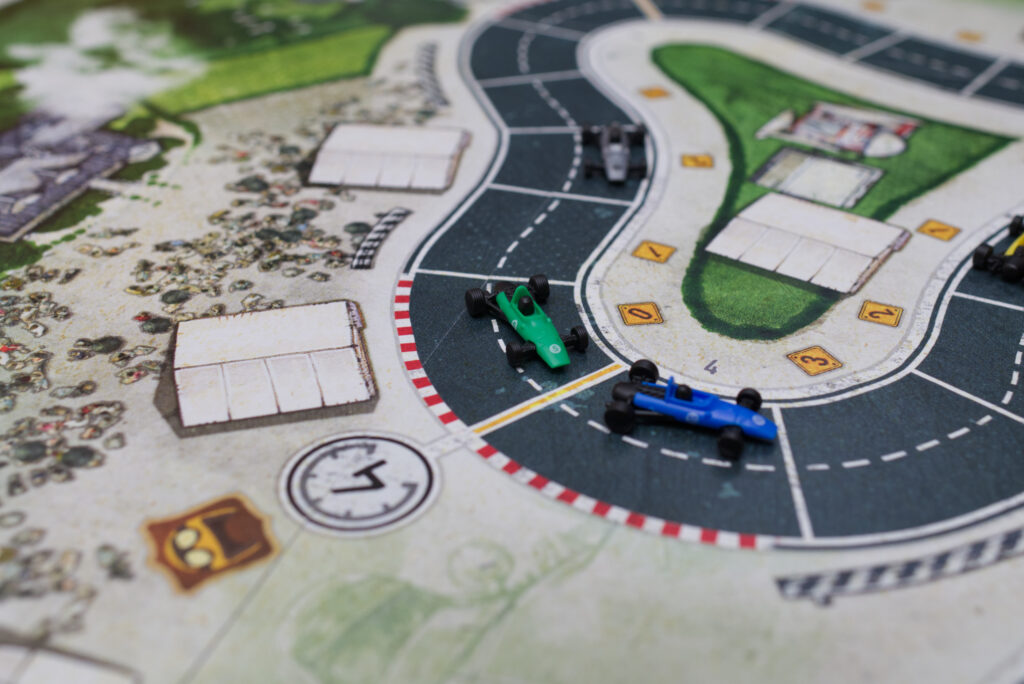
It’s crazy to think about it. On the one hand, I want to say “give them to me, I buy them all tomorrow” and on the other hand I’m thinking “oh my god, so many expansions”. So probably a good idea to design them now and then drip them out one by one.
Of course when and how and release plans and schedules, etc, is the publisher’s decision. And planning that in, designing that.
If you have so many ideas, why did you pick the mechanic of puddles of water for the first expansion?
[with a smile] Because we like to make people spin out more [both laugh]. You asked if there were design philosophies of the first four tracks we included in the base game. So we did not want to actively make people spin out but [mischievously] we think it is something you should all experience more, so here you go. A present from us! [both laugh]
And based on what it does, it makes it harder to shift down and of course [laughs] we placed it at the end of long straights people wanna go fast.
And you made it an integral part of the tracks you are designing and not part of the modular weather system.
Yes. Many of these ideas we have are hard to implement if they go into the weather and road condition system where it would affect a whole sector. Whereas if we can choose where and how we want to apply it – and maybe for future stuff there’s some effects that are only in one lane and not in two of the lanes – that gives us so much more control. Of course it would be fantastic to also make some element where you could make even more repayable or customisable features. But we would rather deliver a strong story with the rains and also have that bit of story of the expansion and make sure that’s perfect and gives you a new experience … [smiling] and then come back for expansion number two if you want even more.
Makes total sense. I hope you will also be expanding the championship system because I really like it and I always felt like “why are there only so few in the base game?” Will there be more?
Yes. So – as of now – the core set of expansions we are working on […] – and certainly the first one – would stick to and is made for this formula: you would get an extra driver, an extra car, of course with the player boards and all the things. You would get an extra board with the two maps attached to it. And then you would get a set of new upgrades with like entirely new symbols and you also get sponsorships matching that new symbol for the championship. And you would also get […] the next season basically.
So in the [base game] you have seasons ’61, ’62, and ’63 and the first expansion would give you ’64. And then we could continue that. Basically, no matter what you like. If you don’t want the seventh player but then maybe you want the map and the upgrades. If you are playing solo maybe you want the extended championship system or whatever it is you want to. There is hopefully something for you in that box.
Sounds like a great mix, I can’t wait.
Thank you.
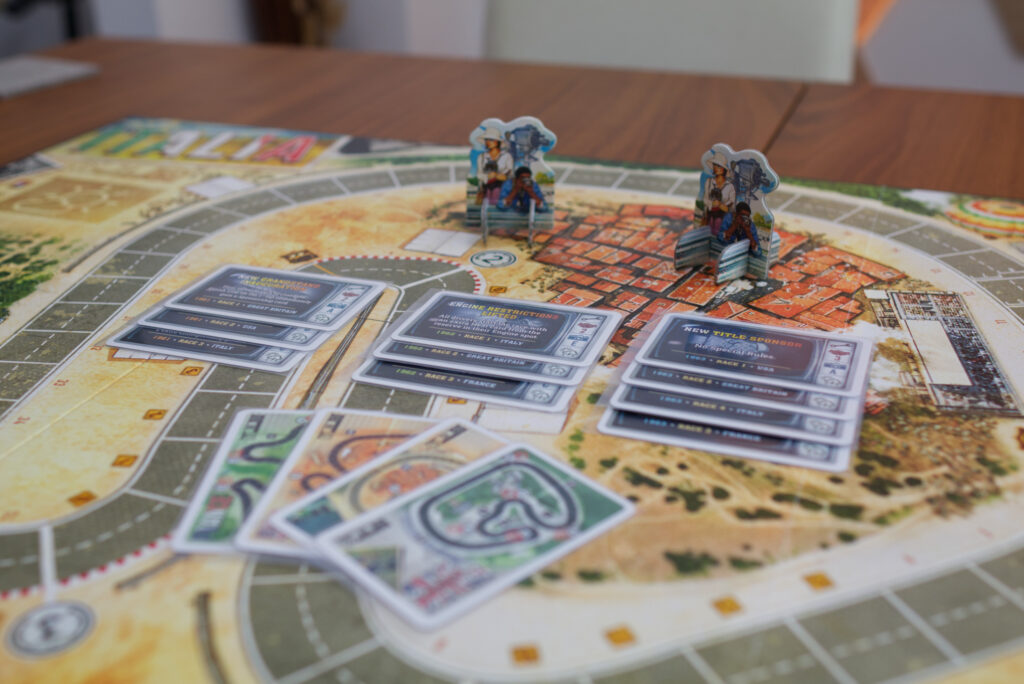
So sign me up for the first one. Is there – with all the things you have planned for the future – some element of racing or this illusion of racing that you think “I want this in this game system” but you are still struggling? Like what’s your white whale of racing?
Oh, my white whale, my Moby-Dick of racing. That’s a good question! So, it’s actually an answer outside of Heat. But maybe just as Flamme Rouge also partially inspired some of the fundamental mechanics or flow of things in Heat, maybe Heat will also be some of the inspiration for this: I would like to try to make a modern Formula 1 racing [game], like a more realistic one, but like bigger pitstops, etc. that would still play relatively fast and smoothly. Less in the Hollywood direction of a movie and more documentary or modern simulation. And I say less and more because it will still be an illusion and will not be actual Formula 1 racing.
But yes, I still have a dream about trying to make that. To satisfy those that want even more racing and that even more realism.
The Lightning Round
So to wrap this up, I thought I do a quick lighting round. How much heat should I have in my deck? How much should I spend it or not?
So my preferred way of doing it of course depends on where on the track you are. Because if you are in a slow corner, you want the heat in your hand, right? And then you should have had it in your deck long enough before to get it in your hand. So it’s all about reading the track and trying to achieve that. Which means that discarding cards is not just about – I’m not giving a lightning answer [chuckles] – but discarding cards is not about what you don’t want on your hand right now or next turn but it’s also about managing when you will shuffle and get stuff in.
At the very simplistic level, my preference is to have my heat in the deck and have my heat available to use. Because if I have too much in the deck, I have the risk of when I’m drawing three or four new cards drawing like a complete hand of only heat cards, which at the wrong time can be a catastrophe. So I don’t like to have all my heat in my deck. At the same time, I’m okay at having half my heat in my discard pile and half my Heat in my deck because then I cannot draw all six of them because they are in different places.
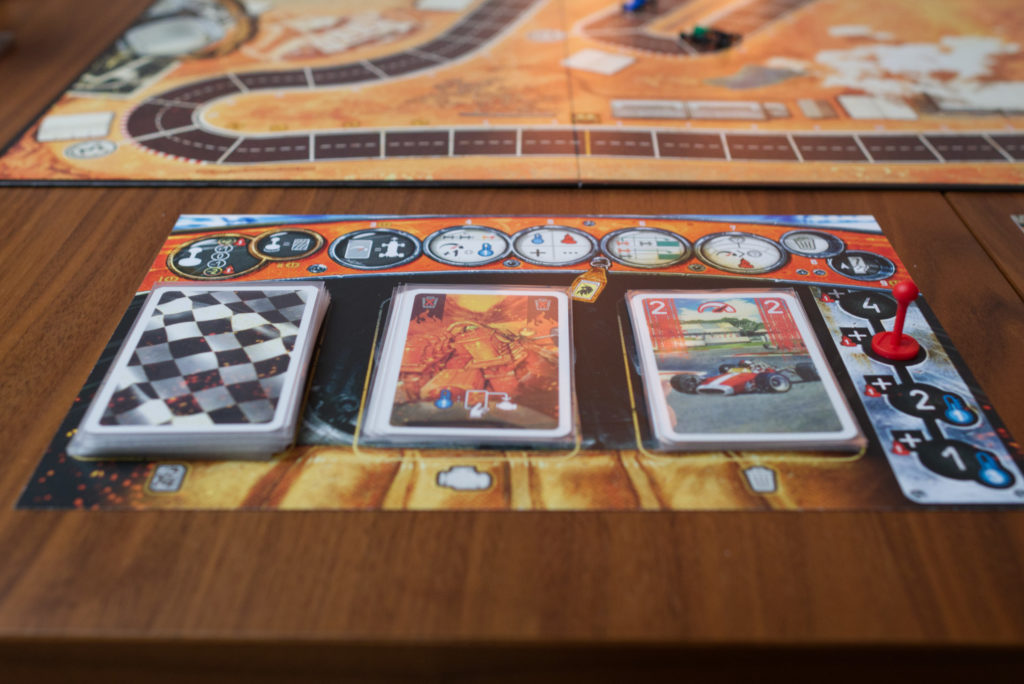
Let’s continue with that: When it comes to the end of your turn and you have to decide how many cards to discard, what goes through your head?
It’s very, very much about getting heat back, that’s what I’m mostly thinking about. [… On] some straights, you have the potential to not lose a turn if you can go fast enough and get down to the corner, so you can go through it [next turn]. But if you land too far from the corner on the straight, then next turn you are gonna slow down, [stop] before the corner, and then go through the corner.
So of course if I have speed cards in that situation, I will keep them, and if I’m very fast towards a very low speed corner, obviously keep my ones. Or at least one of them, somewhat like that as a contingency. But otherwise, especially in the beginning of the game where you have all your heat available, I would maybe go into third gear and do a boost, use some heat early, discard a lot of cards to make sure I can start drawing those heat back up and get them in again.
Everybody has the same cards and heat. So one of the things when a game of Heat is finished that is not identical to everyone is how many heat cards they have used because a heat card being used can come back and be used again and again and again. Generally, whoever is better at that will move faster through corners and break more rules or boost more and do more extra things. So the more you can get your heat back and then out again, the better. But of course it’s the timing of it, because doing it at the wrong time will be a hindrance instead of a help.
Would you also say that that is the difference between good players and not so good players? Knowing that you constantly have to spend heat?
Yes, and also so many players don’t think about discarding cards and discarding more cards. They keep a card if it has the potential to be useful. And it’s almost the other way around that it has to be quite useful for you to keep it. It must be almost needed.
And then there are all the situations where if you have all your stress cards out of your deck, now you maybe don’t want to discard because the slower you go through your deck the longer it takes time to get your stress cards back. The stress cards, the heat, the corners coming up, the exact placing of your heat, is it in your draw deck, in your discard or in your engine, all effect these tiny dilemmas, making it difficult.
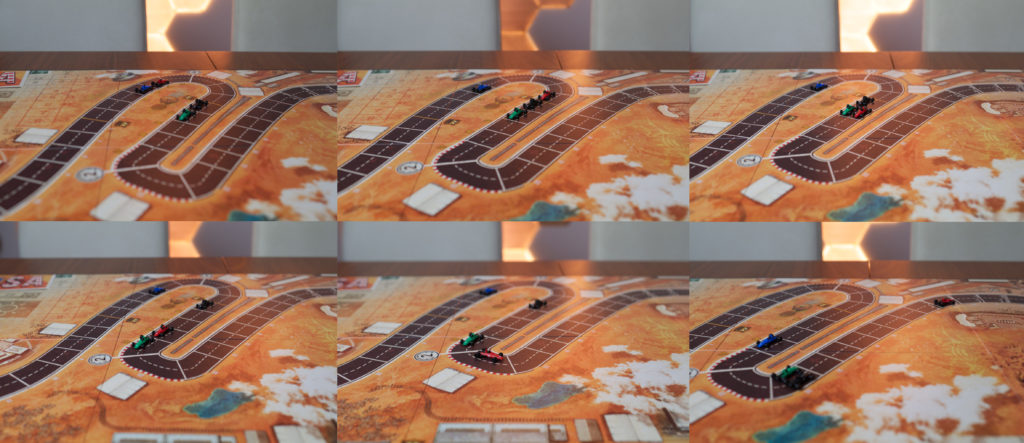
And finally, what’s a small detail in Heat – in the design or in the production – which you really like?
I love the cars from the [finished product]. Of course a lot of the design goes around how big can you make them because of course they are also the toy factor and nice to look at, and the bigger the nicer. But for the size of them – they are quiet small – I think they are very cool.
A small detail from the design that I like? … I think the way that slipstream in a very simple way creates interaction between players is really nice. The number of times where Daniel and I have played the game against the bots, the two of us, and we are sitting one in front of the other, going through a corner, and it’s a corner three, we have plenty of heat, maybe not plenty but … Do you want to go the exact speed and not spend any heat? Or do you wanna go one faster because then if you are in front, the other guy won’t slipstream, and if he gets to slipstream, he will save some more heat on the next corner. All these things.
And then sometimes you even [decide to] go slower, right? So you could go through the corner with a three without paying anything. But sometimes you go two because HE overshoots you, and now you are behind him and then next time you can get it and he spends heat trying to do it, etc. Yeah, those small mind games when you succeed in landing that, and it’s very much the slipstream that allows it.
And you made it extra juicy because slipstream does not count towards the limit of the corner speed, right? So if you are able to guess where someone is, it’s even nicer because you can move around a corner.
Feels like you get a small thing for free. And everybody likes something for free. [both laugh]
Very cool. This was amazing, thanks a lot for the opportunity to talk to you.
This concludes the interview. Many thanks again to Asger for taking the time and sharing all those great anecdotes and insides on how he and Daniel took the game from its initial idea to what it is today.
If you enjoyed reading this, please leave a feedback in the comments. Doing in-depth interviews like these takes a lot of prep & research and it’s really rewarding to see that so many of you seem to enjoy reading them. Showing your support helps getting future interview partners on board! You can find more interviews like these in the interview section.
(Disclaimer: Since Asger and I are both non-native English speakers, I made some smaller corrections to ease the flow of reading and marked them accordingly. Also I have to stress what a fun conversationalist Asger is as this will be difficult to convey in the transcript alone. Whenever he made comparisons to other games or recounted internet comments he had seen, it was with appreciation and respect in his voice, a huge twinkle in his eyes and a smile on his lips.)
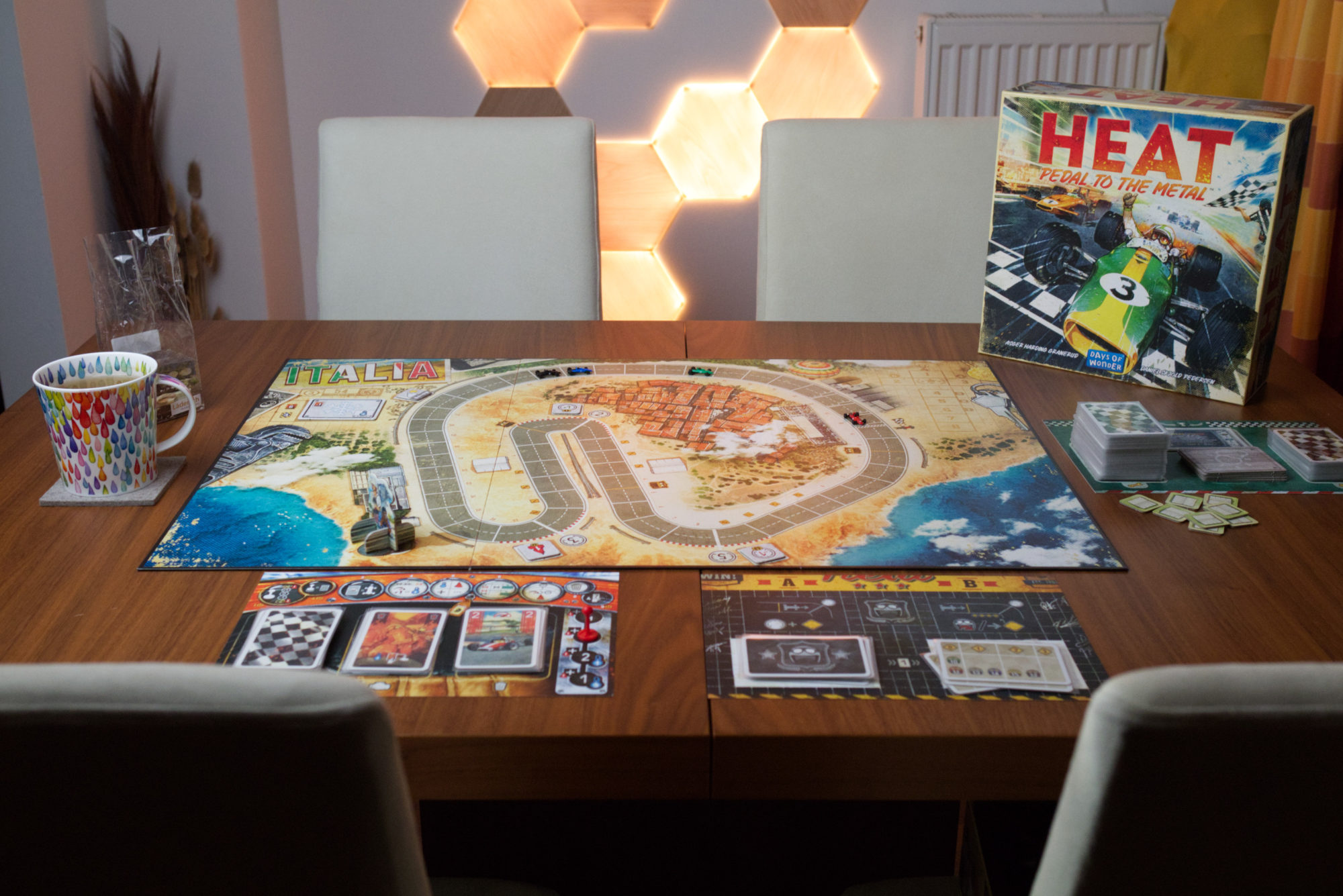
I’m loving your origin series! Thanks for such in-depth and exhaustive interviews, I enjoy them very much!
Thanks so much for the nice feedback!